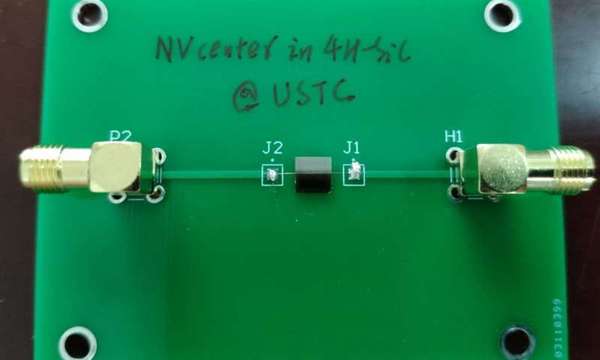[Phys.org]Manufacturing-friendly SiC boasts quantum credentials at telecom wavelengths
Decoherence is the bane of quantum technologies. In coherent systems, the phase of the wave functions representing the quantum states of particles in the system have definite relations between each other. This allows quantum devices to operate in a meaningful way that differs from classical devices. However, interacting with the world around us rapidly leads to decoherence, which makes it harder to exploit quantum effects for enhancing computation efficiency or communication security. Research has shown that quantum systems with impressively long coherence times are possible in diamond, but diamond is far from the favorite for manufacturers. Now, researchers at the University of Science and Technology in Hefei and Wuhan University in China have demonstrated SiC can boast some of the quantum merits of diamond with the additional advantage of optical control at the wavelengths used by the telecommunications industry.
The defects prized for quantum technologies are nitrogen-vacancy (NV) centers, in which a carbon atom in diamond is replaced by a nitrogen with a missing carbon at the neighboring crystal lattice site. What makes this kind of defect interesting for quantum technologies is that you can control its quantum spin states with light and produce photon-spin entanglement with long coherence times, even at room temperature. The difficulties arise when trying to position the technology in the real world as opposed to the lab. The photon-spin interactions for NV centers in diamond need light at visible wavelengths—telecommunications wavelengths are much longer. In addition, these finely engineered devices need to be hacked out of one of the hardest (and most expensive) materials known to man, one that industry does not have established nanofabrication protocols for.

A photo of the device made from SiC with NV centres. (Image by WANG Junfeng)
It turns out there are types of defects in SiC that might also be useful for quantum technologies. SiC is widely used in power electronics, so commercially viable avenues for producing SiC devices already exist. Over the past 10 years, vacancies and divacancies (where one or a pair of atoms in the lattice are absent) in SiC began to attract interest when researchers learned that they could also control their spin states with light at room temperature with long coherence times. The observation of NV centers in SiC really piqued interest, as these were optically active at the wavelengths used by the telecommunications industry as opposed to the shorter visible wavelengths needed to control the spin states of vacancies and divacancies in SiC. We were also interested in the question whether NV centers in the technical material SiC can be coherently controlled like those in diamond, says Jin-Shi Xu, researcher at the University of Science and Technology of China, Hefei, Anhui and one of the corresponding authors on the report of these latest results.
Optimized implantation
Simply blasting a sample with nitrogen atoms can create NV centers in SiC, as the impact causes nitrogen atoms to take the place of host atoms and elbow a neighboring atom out the way at the same time. You can then see how the defects created behave and whether they may be useful for quantum technologies by measuring different optical responses, such as optically detectable magnetic resonance, photoluminescence and zero phonon lines (where laser light excites the state of the defect without giving or taking energy from lattice vibrations).
One complication is that the impact can blast a lot of other host atoms out the way, too, producing unwanted vacancies and divacancies. The divacancies can prove particularly awkward as they resemble NV centers with some of the optical measurements. In addition, there are not only many kinds of NV centers with different orientations within the crystal lattice, but many polymorphs of SiC as well. We were greatly interested in NV centers in 3C-SiC with the ZPL [zero phonon line] being in the c-band telecom range, but after trying many different samples, we still could not detect the corresponding ZPLs, says Xu. We then turned to the 4H-SiC and obtained exciting results.
By controlling the annealing temperature, Xu and fellow USTC researcher Chuan-Feng Li and their collaborators were able to increase the signal from the NV centers with respect to the divacancies. Adjusting other parameters such as annealing time also helped so that they were able to increase the concentration of NV centers by a factor of six. Previously, people did not know whether NV centers could be isolated, he says. We tried optimizing the implant fluence and temperature, and we finally found that it worked.
With the implantation parameters optimized, the researchers then tested how much if any coherent optical control they had over the spin-state system. When a quantum system with two available states is illuminated by light at the frequency exactly equating to the energy difference between the states, the system will flip between states at a characteristic frequency. By measuring these Rabi oscillations, the researchers could confirm that they had coherent control over their system, and that this lasts with a coherence time (T2) of 17.2 μs.
The observed coherence times are still shorter than those for NV centers in diamond where a T2 of milliseconds has been observed. However, it does compete with the coherence times observed for divacancies in SiC, with the additional advantage of operating at telecommunication wavelengths. In addition, the researchers already have in mind strategies that could increase the decoherence time further, including lower nitrogen concentration and the dynamic decoupling technology. The work poses a coherent argument for further investigations of NV centers in SiC for quantum computing.
Phys.org, 2020-05-06,
https://phys.org/news/2020-05-manufacturing-friendly-sic-quantum-credentials-telecom.html
Back
